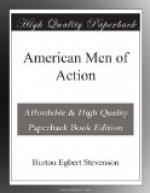Jones, meanwhile, had overhauled and refitted his ship, and on the tenth of April, set sail from Brest, intending to make a complete circuit of the British Isles. Entering the Irish Sea, he spread terror along its shores, where his coming was like a bolt from the blue, engaged and captured the British ship-of-war Drake, took a number of prizes, and sailed into Brest again after an absence of twenty-eight days.
It has been the fashion in some quarters to call Jones a pirate, but it is difficult to see any argument for such a characterization of him. He sailed under the flag of the United States, held a commission from the United States, and attacked an enemy with whom the United States was at war. There is no hint of piracy about that; but Jones came to be a sort of bogeyman to the coast towns of the British Isles, who never knew when to expect an attack from him, and no name was too hard for their frightened inhabitants to apply to him.
But it was some time before Jones was able to strike another blow. He realized that he must have a more effective squadron for his second cruise, and more than a year was spent in getting it together. Finally, on August 14, 1779, he got to sea again with a squadron of four vessels—not a very effective one, but the best that could be had. The flagship was an unwieldy old Indiaman which Jones had named the Bon Homme Richard, in honor of his good friend, Benjamin Franklin, whose Poor Richard was almost as famous in France as in America. The other three ships were commanded by Frenchmen, and all the crews were of the most motley description. On September 23, the squadron sighted a great fleet of English merchantmen, under convoy of the Serapis, a powerful frigate mounting forty-four guns, and the Countess of Scarborough, mounting twenty-eight. Jones signalled his squadron to give chase and himself closed with the Serapis.
Captain Pearson, of the Serapis, was very willing for the contest, since his ship was greatly superior to Jones’s old boat in fighting qualities; but Jones succeeded in depriving the Serapis of some of this advantage by running his vessel into her and lashing fast. So close did they lie that their yardarms interlocked, and their rigging was soon so fouled that Jones could not have got away, even had he wished to do so. For three hours the ships lay there, side by side, pouring broadsides into each other; their decks were soon covered with dead and wounded; two of the Richard’s guns burst and her main battery was silenced, but Jones kept fighting on, for a time with so few guns that the captain of the Serapis thought he had surrendered.
“Have you struck?” he shouted, through his trumpet.
“No,” Jones shouted back, “I have not yet begun to fight!”
The Serapis was on fire and the Richard was sinking, but at this juncture, one of the men of the Richard crept out along a yardarm, and dropped a hand grenade down a hatchway of the Serapis. It wrought fearful havoc, and Pearson struck his flag.




